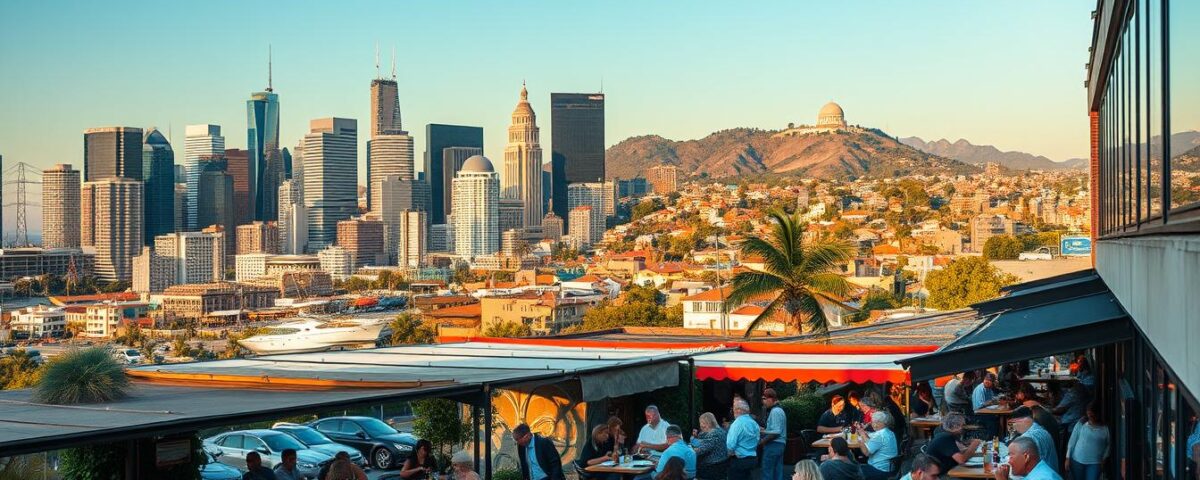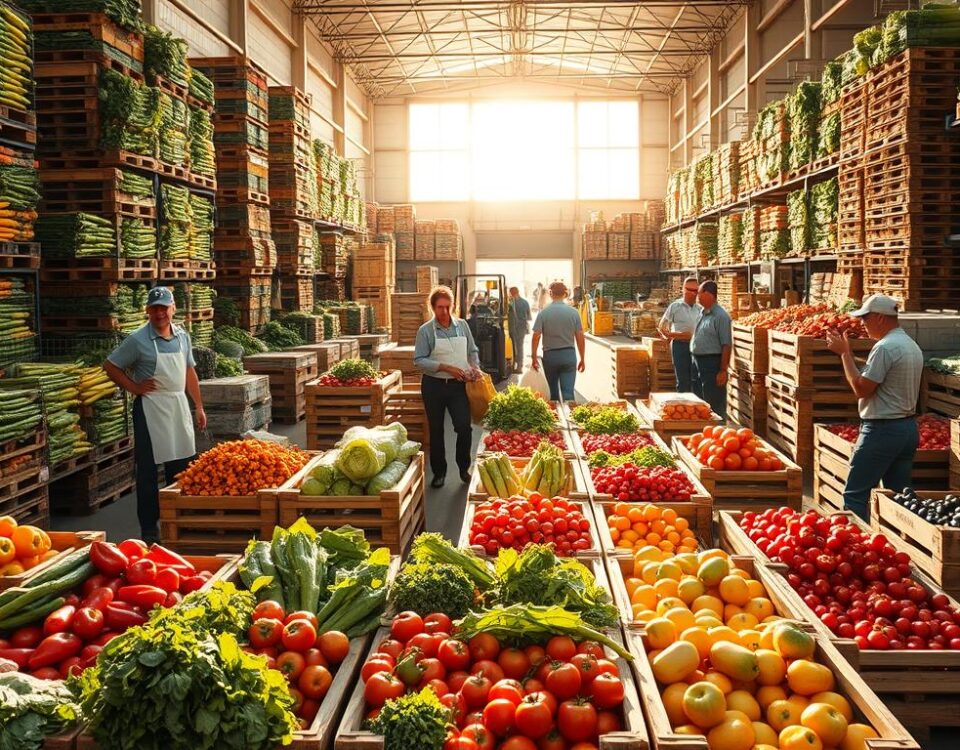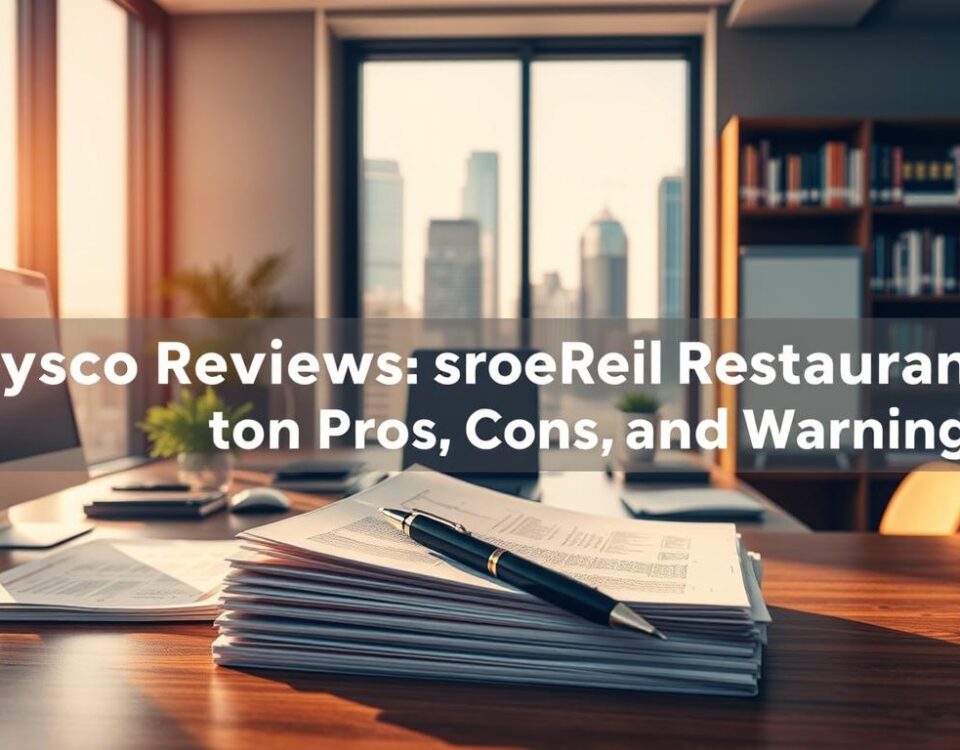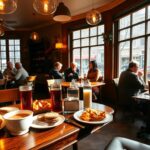
Top Places to Try Traditional Food in Amsterdam
June 9, 2025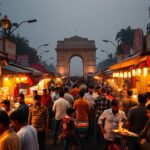
How to Explore the Flavors of Delhi Like a Street Food Pro
June 9, 2025Did you know 60% of America’s major fast-food chains were born in Los Angeles? Yet, this city’s culinary soul runs deeper than drive-thrus. Let me tell you about the time I stumbled upon a tiny family-run spot near Griffith Park. Instead of greasy fries, they served smoky grilled artichokes drizzled with chili-lime butter—a dish that changed how I saw LA’s food culture forever.
LA’s kitchens have always blended tradition with reinvention. I’ve watched burger joints here evolve into gourmet hubs, where chefs riff on classic menus with ingredients like gochujang aioli or heirloom tomatoes. The same creativity that birthed the drive-through now fuels plant-based al pastor tacos and sushi-grade poke bowls served in retro diners.
What makes this city special isn’t just its iconic brands—it’s the stories simmering in every neighborhood. From the sizzle of Korean BBQ in Koreatown to the citrus-kissed ceviche carts downtown, quality and diversity define modern dining here. Let’s explore how LA’s fast-food roots grew into a forest of flavors waiting to be tasted.
Key Takeaways
- Los Angeles birthed major fast-food chains but offers far richer culinary experiences
- Local chefs blend global flavors with classic American comfort foods
- Neighborhood gems serve innovative dishes that redefine casual dining
- Historic drive-through culture has evolved into creative food concepts
- Fresh, high-quality ingredients elevate even simple menu items
Introduction to LA Dining Beyond Fast Food
I once watched a chef in Santa Monica transform a classic burger into a kimchi-layered masterpiece using grass-fed beef from a ranch 20 miles away. That’s when I realized: this city doesn’t just serve meals—it stages edible revolutions.
What Sets LA Apart
No other U.S. city blends global traditions with local ingredients so fearlessly. Walk into a Baldwin Park eatery, and you’ll find fourth-generation cooks swapping family recipes for chile-roasted cauliflower tacos that outshine any drive-thru. The secret? Chefs here treat “fast” as a rhythm, not a compromise.
The City’s Unique Culinary Identity
Three elements define modern LA dining:
- Cross-cultural collisions: Sushi burritos meet Oaxacan mole in strip mall gems
- Seasonal obsession: Menus change weekly to showcase farmers’ market hauls
- Everyday theater: Meals feel like events, whether served on food trucks or linen napkins
A regular at my favorite Venice spot put it best:
“They could charge triple, but the joy’s in seeing people lick their plates.”
That’s the spirit fueling everything fromsourdough pizza trucksto high-end vegan bistros. Here, every bite tells a story older than the freeways.
The Evolution of LA Fast Food Culture in Southern California
It all started with a single hot dog stand in Pasadena, back in 1924. Lionel Sternberger slapped cheese on a beef patty at his family’s roadside joint, accidentally creating America’s first cheeseburger. That spark of ingenuity defined Southern California’s knack for turning simple meals into cultural landmarks.

Roadside Beginnings and Early Innovations
Post-war San Bernardino became ground zero for fast food’s big leap. The McDonald brothers ditched their 25-item barbecue menu in 1948, focusing solely on burgers, fries, and shakes. Their “Speedee Service System” cut wait times to 30 seconds—a revelation for car-crazy customers.
Meanwhile, Glen Bell watched from across town. His taco stand borrowed the assembly-line approach, later evolving into a global chain. These pioneers didn’t just sell meals—they crafted routines for modern life.
The Fast Food Revolution and Its Legacy
By the 1950s, Southern California’s drive-ins buzzed with neon signs and tray-laden servers. Standardized menus ensured you’d get the same crispy fries in Santa Monica as in San Diego. One regular from those early years told me:
“We didn’t realize we were tasting history—just knew those burgers hit different.”
Today’s plant-based nuggets and fusion tacos owe their existence to that era’s obsession with speed and quality. The brands changed, but the hunger for innovation never faded.
Los Angeles beyond fast food: Embracing New Culinary Trends
Last week, a chef whispered something shocking over sizzling jackfruit tacos: “70% of our regulars now demand plant-based twists.” This revelation captures LA’s dining revolution—where avocado toast competes with drive-thrus for breakfast crowds.
Cultural Shifts in Dining Preferences
Menus now read like passports. I’ve tasted miso caramel drizzled on churros in Echo Park and watched Del Taco roll out cauliflower crumbles alongside beef. Even Taco Bell tests al pastor made with oyster mushrooms—proof that chains adapt or fade.
Neighborhoods shape these changes. In Sawtelle, ramen shops add vegan tonkotsu broth. Downtown, a century-old market hosts vegan birria stalls. One vendor told me:
“Regulars want bold flavors without the guilt.”
Three forces drive this shift:
- Global palates: Third-wave coffee stands serve matcha horchatas
- Ingredient pride: Menus spotlight local farms like Tanaka Ranch
- Speed meets craft: Meals take minutes but taste like slow-cooked labors
While classic drive-throughs still thrive, the real action happens where cultures collide. At a Koreatown food court last Tuesday, I joined office workers devouring kimchi quesadillas—a perfect snapshot of LA’s remixed food identity.
Iconic Fast Food Legacies Reinvented for Today’s Eater
A chef friend recently confessed that revamping a classic menu item feels like time travel with a twist. Chains once known for standardized menus now compete to surprise customers. I tasted proof at a Baldwin Park location where crispy orange chicken gets tossed with kale in Panda Express’ new grain bowls—a far cry from 1980s mall food courts.
Revamped Classics with a Modern Twist
Menus now read like culinary lab reports. Carl’s Jr. swapped beef for Beyond Meat in their iconic Western Bacon Cheeseburger, while Bob’s Big Boy serves vegan milkshakes beside their famous double-decker. Even hot dog stands elevate their game—I tried one topped with kimchi and gochujang aioli last Thursday.
| Classic Item | Modern Twist | Key Ingredient |
|---|---|---|
| In-N-Out Burger | Protein-Style Wrap | Lettuce instead of bun |
| Del Taco Crunchtada | Plant-Based Chorizo | Soy protein blend |
| Panda Express Chow Mein | Zucchini Noodles | Spiralized vegetables |
Fusion Flavors and Creative Menus
The real magic happens when cultures collide. At a Glendale food truck, I devoured bulgogi fries drizzled with queso—a Korean-Mexican hybrid that’s now their top seller. One chain manager told me:
“We keep the soul of our recipes but let global flavors lead the dance.”
From sushi-grade tuna tacos to matcha soft serve, these updates prove tradition and innovation can coexist. The secret? Respect the original while daring to experiment. That balance keeps regulars nostalgic and newcomers curious.
Sustainable and Locally-Sourced Dining Experiences
I nearly dropped my reusable cup when a server told me their patio umbrellas were made from recycled fishing nets. This moment at a Silver Lake café epitomizes LA’s shift toward earth-conscious dining—where even the decor tells an eco-story.

The Rise of Eco-Friendly Eateries
Chefs now treat sustainability like a sixth taste. At a new Culver City spot, I watched cooks transform “ugly” produce into vibrant grain bowls. Their secret? Partnering with farms within 50 miles to reduce waste and carbon footprints.
Fast-food chains join the movement too. A popular burger brand recently swapped plastic straws for pasta alternatives—a small change saving 12 million single-use items yearly. One manager shared:
“Guests cheer when we explain how their meal supports local dairies.”
| Practice | Sustainable Approach | Impact |
|---|---|---|
| Packaging | Compostable containers | 65% less landfill waste |
| Produce | Hyper-local sourcing | 24-hour farm-to-table timeline |
| Energy | Solar-powered kitchens | 40% lower emissions |
These efforts ripple beyond plates. A family-run taco stand in Boyle Heights now uses rooftop herbs, cutting costs while attracting eco-minded foodies. Their story mirrors citywide trends—79% of diners here prefer spots with green certifications.
From solar-charged food trucks to zero-waste bakeries, Southern California proves sustainability enhances flavor. As one farmer told me while handing me sun-warmed strawberries: “Good food starts with happy soil.”
Hidden Culinary Gems and Authentic Spots in Los Angeles
Tucked behind a laundromat in East LA, I discovered a family-run pupuseria that’s been crafting handmade tortillas since 1987. These unassuming spots—often overshadowed by flashy chains—hold the city’s true flavor secrets. Forget GPS coordinates; the best meals here come with directions like “look for the neon cactus” or “follow the smell of smoked paprika.”
Local Favorites and Neighborhood Hotspots
In Sawtelle Japantown, a 24-seat ramen shop serves miso broth simmered for three days straight. Regulars whisper about their off-menu truffle-kimchi dumplings, available only on rainy Tuesdays. One critic tipped me off to a Santa Monica seafood shack where fishermen trade catches for chowder—their garlicky clam toast rivals Michelin-starred plates.
Three spots redefine neighborhood dining:
- A Highland Park burger joint using grass-fed beef from a ranch visible from their patio
- A Boyle Heights taco stand where orders come on handmade blue corn tortillas
- A Koreatown basement serving spicy octopus stew to night-shift workers since 1992
“These places aren’t hiding—they’re waiting for those willing to look closer,”
Secret Menus and Off-the-Beaten-Path Finds
I once scored churro waffles at a Silver Lake coffee shop by asking for “the sunrise special.” Many spots thrive on word-of-mouth treasures. A Venice Beach hot dog cart offers an unlisted Korean BBQ dog wrapped in nori—just say you want “Steve’s usual.”
| Spot | Secret Order | What You Get |
|---|---|---|
| Echo Park Diner | “Midnight Pancakes” | Ube-flavored stacks with coconut syrup |
| Downtown Food Hall | “The Ninja Bowl” | Sushi rice with spicy tuna and crispy garlic |
| Arts District Brewery | “Hoppy Hour” | Beer-braised pretzel with ghost pepper cheese |
These culinary whispers prove LA’s dining scene thrives in its cracks and corners. Next time you pass a faded sign or hear sizzling from an alley—follow the scent. The city’s best meals often come without fanfare, but with soul.
Influence of Car Culture on the LA Food Scene
The first time I saw a tray clipped to a car window, I knew dining would never be the same. LA’s love affair with wheels shaped its food DNA—think neon-lit drive-ins where servers roller-skated meals to Chevys. Brands like Bob’s Big Boy turned parking lots into dining rooms, with carhops delivering double-decker burgers to families still in their Sunday best.
Drive-throughs weren’t just convenient—they rewrote restaurant rules. The McDonald brothers scrapped silverware in 1948, designing their Speedee Service System for drivers craving quick bites. A regular at their original San Bernardino spot once told me:
“We’d honk twice for extra ketchup—they’d slide fries through half-open windows.”
Today’s food landscape still mirrors freeway rhythms. Chains like Taco Bell test AI-powered lanes that predict orders before you speak. But the roots run deeper:
| Era | Innovation | Impact |
|---|---|---|
| 1940s | Carhop service | Meals became social events |
| 1950s | Drive-through windows | 30-second meal turnover |
| 2020s | App-based curbside pickup | Zero-contact dining |
In Baldwin Park, I watched teens customize hot dogs via touchscreen—a far cry from handwritten menus. Yet the spirit remains: food that meets you where you are. From chrome-finned cruisers to Teslas, LA’s meals move at the speed of life.
Conclusion
Sitting at a sunlit counter watching chefs fuse miso paste with heirloom corn, I realized this city’s true magic. Los Angeles doesn’t abandon its fast food roots—it elevates them. Every chili-dusted taco and plant-based burger carries decades of reinvention.
From Del Taco’s vegan chorizo to Carl’s Jr. testing solar-powered kitchens, the old guard adapts while newcomers rewrite rules. I’ve tasted this evolution firsthand—in family-run spots where recipes outlive buildings, and chains where customers customize orders via app.
What’s next? Menus celebrating global flavors and zero-waste practices. Neighborhood joints serving heritage dishes beside avocado-laced innovations. Whether craving Big Boy nostalgia or hunting hidden ceviche carts, every meal here tells a story.
Thank you for sharing this culinary journey. Now it’s your turn—grab friends, follow sizzling sounds down alleyways, and taste how a city reimagines dining daily. Your perfect plate awaits where tradition dances with tomorrow’s flavors.
FAQ
What makes Southern California’s dining scene unique compared to other cities?
I’ve found that the blend of cultures here creates flavors you won’t find elsewhere. From Korean-Mexican fusion to farm-to-table spots in Santa Monica, it’s a mix of innovation and tradition shaped by decades of immigrant influence.
How did car culture shape the way people eat here?
Drive-ins and roadside stands like the original McDonald’s in San Bernardino set the tone. Even today, places like Pink’s Hot Dogs or taco trucks thrive because grabbing meals on-the-go is baked into the city’s DNA.
Are there iconic fast-food spots worth trying for a taste of history?
Absolutely! Bob’s Big Boy in Burbank still serves its classic Super Burger, while Philippe the Original claims to have invented the French dip sandwich. These spots honor their roots while keeping menus fresh.
Where can I find hidden gems that locals love?
Skip the chains and explore neighborhoods like Silver Lake or Boyle Heights. My go-tos include family-run pupuserias and sushi bars in Little Tokyo—look for spots with lines out the door!
How have eco-friendly practices changed dining here?
Many chefs now prioritize local sourcing, like using produce from Santa Monica Farmers Market. Restaurants like Sqirl in East Hollywood even repurpose food waste into creative dishes, proving sustainability can be delicious.
What’s a must-try dish that represents modern LA cuisine?
Try the kimchi-topped fries at a Koreatown pub or a vegan “chorizo” burrito in Highland Park. These twists on classics show how the city’s food scene keeps evolving without losing its soul.
